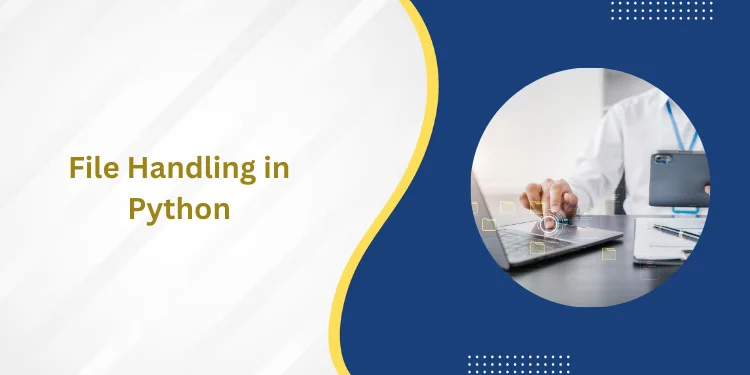Table of Contents
ToggleIntroduction
If you’re looking for a way to better manage your data, understanding and utilizing file handling in Python is a great place to start. File handling in python allows you to create different types of files that can store and manipulate data for your programs.
First, let’s talk about the different types of files that can be created. Common file types include text files, CSV (comma separated value) files and JSON (JavaScript Object Notation) files. Text files store data as plaintext, while CSV and JSON are popular formats for storing structured data.
The next step is to create the files or directories that will house the data you’re working with. To do this, you’ll need to use the proper functions in your Python program. For example, if you want to create a directory, you’ll use the os.mkdir() function; similarly, if you want to create a text file, you’d use the open() function with “w” as an argument.
Finally, once the file or directory has been created successfully, it’ll need to be opened so that operations can be carried out on it. To open a file in Python, all you have to do is call the open() method using the name of the file as an argument; from there it can be manipulated using various read or write operations until it’s closed again with close().
In conclusion, understanding how to file handling in Python is essential for any programmer who wants to work with large amounts of data.
What is File Handling in Python?

Python too supports file handling and allows users to handle files i.e., to read and write files, along with many other options in file handling in python, to operate on files. The concept of file handling has stretched over various other languages, but the implementation is either complicated or lengthy, but like other concepts of Python, this concept here is also easy and short. Python treats files differently as text or binary and this is important. Each line of code includes a sequence of characters and they form a text file.
Each line of a file is terminated with a special character, called the EOL or End of Line characters like comma {,} or newline character. It ends the current line and tells the interpreter a new one has begun. Let’s start with the reading and writing files.
Working of Open() Function

Before performing any operation on the file like reading or writing, first, we have to open that file. For this, we should use Python’s inbuilt function open() but at the time of opening, we have to specify the mode, which represents the purpose of the opening file.
f = open(filename, mode)
Where the following mode is supported:
- r: open an existing file for a read operation.
- w: open an existing file for a write operation. If the file already contains some data then it will be overridden but if the file is not present then it creates the file as well.
- a: open an existing file for append operation. It won’t override existing data.
- r+: To read and write data into the file. The previous data in the file will be overridden.
- w+: To write and read data. It will override existing data.
- a+: To append and read data from the file. It won’t override existing data.
These are just some basics of reading and writing.
Binary File Handling
Binary File Handling in Python is an essential skill for any python programmer. It allows you to read and write data from a file using various operations. This article will cover the basics of file types, open/close files, read/write data, binary mode, reading errors, opening modes, writing errors and the seek function.
File Types:
There are two types of files: text files and binary files. Text files are plain ASCII strings that store textual information in a humanly readable form. Binary files contain binary data in a non readable form. They can be used to store executable programs or multimedia objects such as images or sound clips.
Open/Close Files:
In order to read/write data from a binary file, it must first be opened with the correct mode argument (read, write or append). After the operations have been completed on the file, it must be closed with the close() function.
Read/Write Data:
When reading and writing to a binary file you need to specify which mode you want to use; this is done by passing in one of the constants ‘rb’ for readonly binary access or ‘wb’ for write only binary access into the open statement when opening a file. By default read/write operations with a binary file will be performed using byte streams (i.e., 8 bits at a time).
Binary Mode:
It’s important to note that when working with large amounts of data, it’s best practice to use binary mode as it makes for faster transfer speeds over text mode due to its smaller memory footprint.
Opening Files in Python
The open() Python method is the primary file handling in python function. The basic syntax is:
file_object = open(‘file_name’, ‘mode’)
The open() function takes two elementary parameters for file handling:
- The file_name includes the file extension and assumes the file is in the current working directory. If the file location is elsewhere, provide the absolute or relative path.
- The mode is an optional parameter that defines the file opening method. The table below outlines the different possible options:
Mode | Description |
‘r’ | Reads from a file and returns an error if the file does not exist (default). |
‘w’ | Writes to a file and creates the file if it does not exist or overwrites an existing file. |
‘x’ | Exclusive creation that fails if the file already exists. |
‘a’ | Appends to a file and creates the file if it does not exist or overwrites an existing file. |
‘b’ | Binary mode. Use this mode for non-textual files, such as images. |
‘t’ | Text mode. Use only for textual files (default). |
‘+’ | Activates read and write methods. |
The mode must have exactly one create(x)/read(r)/write(w)/append(a) method, at most one +. Omitting the mode defaults to ‘rt’ for reading text files.
Advantages:
- Versatility: File handling in Python allows you to perform a wide range of operations, such as creating, reading, writing, appending, renaming, and deleting files.
- Flexibility: File handling in Python is highly flexible, as it allows you to work with different file types (e.g. text files, binary files, CSV files, etc.), and to perform different operations on files (e.g. read, write, append, etc.).
- User–friendly: File handling in Python provides a user-friendly interface for file handling, making it easy to create, read, and manipulate files.
- Cross-platform: File handling in Python file handling functions work across different platf
orms (e.g. Windows, Mac, Linux), allowing for seamless integration and compatibility.
Disadvantages:
- Error-prone: File handling in Python can be prone to errors, especially if the code is not carefully written or if there are issues with the file system (e.g. file permissions, file locks, etc.).
- Security risks: File handling in Python can also pose security risks, especially if the program accepts user input that can be used to access or modify sensitive files on the system.
- Complexity: File handling in Python can be complex, especially when working with more advanced file formats or operations. Careful attention must be paid to the code to ensure that files are handled properly and securely.
- Performance: File handling in Python can be slower than other programming languages, especially when dealing with large files or performing complex operations.
Overall, file handling in Python is a powerful and versatile tool that can be used to perform a wide range of operations. However, it is important to carefully consider the advantages and disadvantages of file handling in Python when writing programs, to ensure that the code is secure, reliable, and performs well.
Coding Practices for Writing Better Code with File Handling

File handling in Python is an important part of coding and understanding the basics of how to read, write, and handle files can help your code become more organized, efficient, and secure. Let’s take a look at some coding practices and best practices for writing better code with file handling in Python.
First, let’s talk about the basics of file handling in python. File handling in Python allows us to store data that can be accessed by our code for various purposes like reading, writing, modifying and deleting data from files. It also allows us to treat a file as an object so that all these operations can be performed on the file. There are many advantages to using file handing in python such as making tasks easier to manage, faster operations when dealing with large files, improved security around data storage and access.
Once you have a basic level understanding of what file handling in python is used for, let’s discuss the reading & writing operations. This is where we actually get into the nitty gritty of what we can do with files using Python code. We have several commonly used modules such as open pyxl (for working with excel files) and csv (for handling comma separated values). Another module that has gained popularity recently is path lib which allows us to read data from multiple sources in a much simpler way than before.
Using path lib we can create a new “File Object” which makes it easier for us to get data from it quickly and efficiently. To begin reading or writing from a File Object you need to use two functions: open() and close().
Mistakes When Working with Files and How to Avoid Them?

Working with files handling in Python can be a complex undertaking and is an important skill that new developers must master. If not done correctly, it can lead to bugs which can be difficult and time consuming to debug. In this blog, we will walk through some common mistakes when working with files, how to avoid them, and how to handle them if they do occur.
When creating or opening a file in Python, it is important to make sure that the correct path is specified and the correct permissions are set for read/write access. Failing to ensure that these are set properly can result in errors when trying to access the file or unexpected outcomes from operations on the file. Additionally, depending on the type of application you are building and its security needs, you may want to consider more stringent permission levels when allowing access to certain parts of your filesystem.
When reading a file, one common mistake is not setting the encoding type correctly as this can result in changes in data format or garbled text being returned instead of what was expected. To avoid this error occurring it is best practice to make sure that you explicitly set the encoding type as UTF8 whenever attempting any kind of read operation on a file.
When writing files, make sure that you have the overwrite option set so that existing content within the file isn’t inadvertently changed or lost without your knowledge when writing new content into it. In addition, always close any open file objects after writing into them as failing to do so may lead to unwanted memory leaks forming over time due to dangling pointers still referencing open files in your system’s memory.
How to Work With Files Easily and Effectively With Python?

If you have ever needed to work with files handling in Python, you know that it can take a bit of effort to learn the ins and outs of the language. But with the right approach, Python makes file handling quite easy and effective.
The very first step of file handling in Python is opening and closing files. When you open a file, you use the open() function, and when you’re done with it, you’ll use the close() function. When using the open() function, you must specify the path of the file as well as its mode (it’s either readonly or writeonly).
Once a file is open for reading or writing, you’ll need to know how to read from it or write to it. To do this, you’ll use functions such as read(), write(), readline(), and writeline(). With these functions, you can manipulate files in various ways depending on your needs.
When working with file formats like CSV and JSON, Python has dedicated modules that make working with them extremely easy. These modules include csv and json respectively; they offer functions such as csvreader()/csvwriter() and load/dump which let you easily parse data from these formats into your program.
Furthermore, manipulating existing file contents is also quite simple using Python. You can copy files using shutil’s copyfile(), move them using move(), rename them using rename(), delete them with remove() ,and even check its size using getsize().
Error handling for files is equally important; without making sure whether a certain operation was successful or not can have disastrous effects on your program.
Conclusion
In conclusion, file handling in Python is an incredibly useful and versatile tool for working with data files. By summarizing the steps we’ve discussed today, you can easily work with a range of file formats and can begin to tailor your data to your exact needs. We’ve outlined the importance of this skill, considering how much of the digital world relies on data collection and manipulation. As well as discussing the results achieved when using these concepts, we highlighted potential applications for practical use as well as any lessons learned along the way that needed to be addressed.
File handling in Python goes far beyond simply managing a single file or folder; it provides you with the skills to use various programming functions to automate processes, such as sorting and storing information quickly and accurately. With this knowledge, you now have an accessible way to store and manipulate large volumes of data quickly using your own code. Now that you understand the benefits of file handling in Python and see its practical implications firsthand, it’s time for you to put your newfound knowledge into practice!
Frequently Asked Questions
What is file handling in Python?
File handling in Python refers to the process of manipulating files using the Python programming language. It includes a wide range of activities, from reading and writing data to encrypting or deleting files, and much more.
How to read from or write to a file in Python?
In Python, when we need to read from or write to a file, it must be opened first. After completing the operation, the file must be closed so that any associated resources are released. Therefore, the order of a file operation in Python is: open the file, read or write (perform operation), close the file.
What are file operations in Python?
File operations in Python involve manipulating files on a computer such as creating, opening, reading, writing, deleting and closing them.
How to open a file in Python?
In order to accomplish this task, it is necessary to utilize Python’s built-in function open(). When opening a file, the mode must be specified in order to indicate the purpose of the opening file. The mode ‘r’ allows us to open an existing file for reading operations, while the mode ‘w’ enables us to open an existing file for writing operations.
Let’s move forward to other question of File handling in Python…
How do I manipulate a file in Python?
In order to manipulate a file, we can utilize the write command in our Python environment. To do this, we must first open the file of our choice (in this example, ‘geek.txt’) by writing ‘file = open(‘geek.txt’,’w’)’, with the ‘w’ indicating that we are opening the file for writing. We can then write whatever we wish in the file by using the line ‘file.write(“This is the write command”)’. If we wish to add additional lines of text, we can use ‘file.write(“It allows us to write in a particular file”)’ for example.
Finally, when our changes have been made, it is important to remember to close out of the file using the command ‘file.close()’. This will terminate all resources in use and free up system memory from this program.













